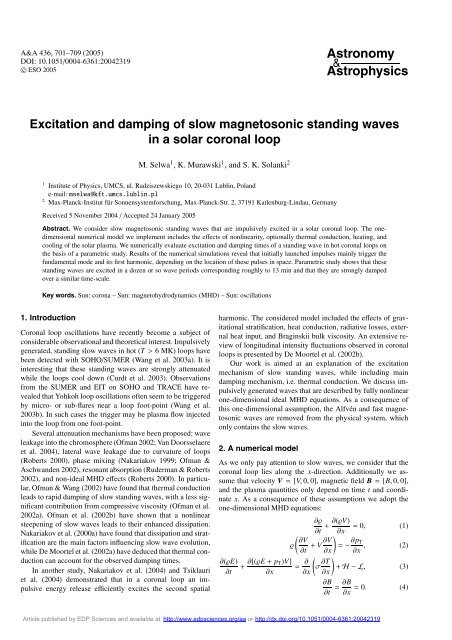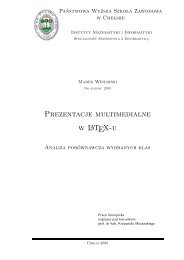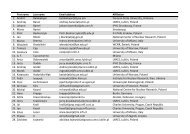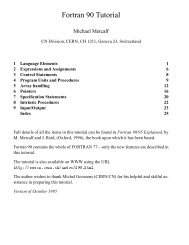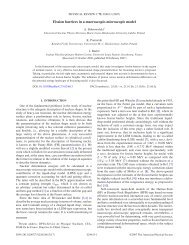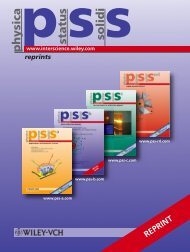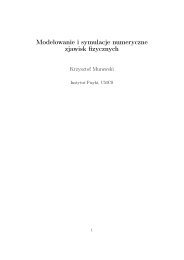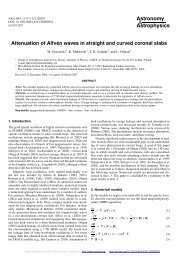Excitation and damping of slow magnetosonic standing waves in a ...
Excitation and damping of slow magnetosonic standing waves in a ...
Excitation and damping of slow magnetosonic standing waves in a ...
You also want an ePaper? Increase the reach of your titles
YUMPU automatically turns print PDFs into web optimized ePapers that Google loves.
A&A 436, 701–709 (2005)<br />
DOI: 10.1051/0004-6361:20042319<br />
c○ ESO 2005<br />
Astronomy<br />
&<br />
Astrophysics<br />
<strong>Excitation</strong> <strong>and</strong> <strong>damp<strong>in</strong>g</strong> <strong>of</strong> <strong>slow</strong> <strong>magnetosonic</strong> st<strong>and</strong><strong>in</strong>g <strong>waves</strong><br />
<strong>in</strong> a solar coronal loop<br />
M. Selwa 1 ,K.Murawski 1 , <strong>and</strong> S. K. Solanki 2<br />
1 Institute <strong>of</strong> Physics, UMCS, ul. Radziszewskiego 10, 20-031 Lubl<strong>in</strong>, Pol<strong>and</strong><br />
e-mail: mselwa@kft.umcs.lubl<strong>in</strong>.pl<br />
2 Max-Planck-Institut für Sonnensystemforschung, Max-Planck-Str. 2, 37191 Katlenburg-L<strong>in</strong>dau, Germany<br />
Received 5 November 2004 / Accepted 24 January 2005<br />
Abstract. We consider <strong>slow</strong> <strong>magnetosonic</strong> st<strong>and</strong><strong>in</strong>g <strong>waves</strong> that are impulsively excited <strong>in</strong> a solar coronal loop. The onedimensional<br />
numerical model we implement <strong>in</strong>cludes the effects <strong>of</strong> nonl<strong>in</strong>earity, optionally thermal conduction, heat<strong>in</strong>g, <strong>and</strong><br />
cool<strong>in</strong>g <strong>of</strong> the solar plasma. We numerically evaluate excitation <strong>and</strong> <strong>damp<strong>in</strong>g</strong> times <strong>of</strong> a st<strong>and</strong><strong>in</strong>g wave <strong>in</strong> hot coronal loops on<br />
the basis <strong>of</strong> a parametric study. Results <strong>of</strong> the numerical simulations reveal that <strong>in</strong>itially launched impulses ma<strong>in</strong>ly trigger the<br />
fundamental mode <strong>and</strong> its first harmonic, depend<strong>in</strong>g on the location <strong>of</strong> these pulses <strong>in</strong> space. Parametric study shows that these<br />
st<strong>and</strong><strong>in</strong>g <strong>waves</strong> are excited <strong>in</strong> a dozen or so wave periods correspond<strong>in</strong>g roughly to 13 m<strong>in</strong> <strong>and</strong> that they are strongly damped<br />
over a similar time-scale.<br />
Key words. Sun: corona – Sun: magnetohydrodynamics (MHD) – Sun: oscillations<br />
1. Introduction<br />
Coronal loop oscillations have recently become a subject <strong>of</strong><br />
considerable observational <strong>and</strong> theoretical <strong>in</strong>terest. Impulsively<br />
generated, st<strong>and</strong><strong>in</strong>g <strong>slow</strong> <strong>waves</strong> <strong>in</strong> hot (T > 6 MK) loops have<br />
been detected with SOHO/SUMER (Wang et al. 2003a). It is<br />
<strong>in</strong>terest<strong>in</strong>g that these st<strong>and</strong><strong>in</strong>g <strong>waves</strong> are strongly attenuated<br />
while the loops cool down (Curdt et al. 2003). Observations<br />
from the SUMER <strong>and</strong> EIT on SOHO <strong>and</strong> TRACE have revealed<br />
that Yohkoh loop oscillations <strong>of</strong>ten seem to be triggered<br />
by micro- or sub-flares near a loop foot-po<strong>in</strong>t (Wang et al.<br />
2003b). In such cases the trigger may be plasma flow <strong>in</strong>jected<br />
<strong>in</strong>to the loop from one foot-po<strong>in</strong>t.<br />
Several attenuation mechanisms have been proposed: wave<br />
leakage <strong>in</strong>to the chromosphere (Ofman 2002; Van Doorsselaere<br />
et al. 2004), lateral wave leakage due to curvature <strong>of</strong> loops<br />
(Roberts 2000), phase mix<strong>in</strong>g (Nakariakov 1999; Ofman &<br />
Aschw<strong>and</strong>en 2002), resonant absorption (Ruderman & Roberts<br />
2002), <strong>and</strong> non-ideal MHD effects (Roberts 2000). In particular,<br />
Ofman & Wang (2002) have found that thermal conduction<br />
leads to rapid <strong>damp<strong>in</strong>g</strong> <strong>of</strong> <strong>slow</strong> st<strong>and</strong><strong>in</strong>g <strong>waves</strong>, with a less significant<br />
contribution from compressive viscosity (Ofman et al.<br />
2002a). Ofman et al. (2002b) have shown that a nonl<strong>in</strong>ear<br />
steepen<strong>in</strong>g <strong>of</strong> <strong>slow</strong> <strong>waves</strong> leads to their enhanced dissipation.<br />
Nakariakov et al. (2000a) have found that dissipation <strong>and</strong> stratification<br />
are the ma<strong>in</strong> factors <strong>in</strong>fluenc<strong>in</strong>g <strong>slow</strong> wave evolution,<br />
while De Moortel et al. (2002a) have deduced that thermal conduction<br />
can account for the observed <strong>damp<strong>in</strong>g</strong> times.<br />
In another study, Nakariakov et al. (2004) <strong>and</strong> Tsiklauri<br />
et al. (2004) demonstrated that <strong>in</strong> a coronal loop an impulsive<br />
energy release efficiently excites the second spatial<br />
harmonic. The considered model <strong>in</strong>cluded the effects <strong>of</strong> gravitational<br />
stratification, heat conduction, radiative losses, external<br />
heat <strong>in</strong>put, <strong>and</strong> Brag<strong>in</strong>skii bulk viscosity. An extensive review<br />
<strong>of</strong> longitud<strong>in</strong>al <strong>in</strong>tensity fluctuations observed <strong>in</strong> coronal<br />
loops is presented by De Moortel et al. (2002b).<br />
Our work is aimed at an explanation <strong>of</strong> the excitation<br />
mechanism <strong>of</strong> <strong>slow</strong> st<strong>and</strong><strong>in</strong>g <strong>waves</strong>, while <strong>in</strong>clud<strong>in</strong>g ma<strong>in</strong><br />
<strong>damp<strong>in</strong>g</strong> mechanism, i.e. thermal conduction. We discuss impulsively<br />
generated <strong>waves</strong> that are described by fully nonl<strong>in</strong>ear<br />
one-dimensional ideal MHD equations. As a consequence <strong>of</strong><br />
this one-dimensional assumption, the Alfvén <strong>and</strong> fast <strong>magnetosonic</strong><br />
<strong>waves</strong> are removed from the physical system, which<br />
only conta<strong>in</strong>s the <strong>slow</strong> <strong>waves</strong>.<br />
2. A numerical model<br />
As we only pay attention to <strong>slow</strong> <strong>waves</strong>, we consider that the<br />
coronal loop lies along the x-direction. Additionally we assume<br />
that velocity V = [V, 0, 0], magnetic field B = [B, 0, 0],<br />
<strong>and</strong> the plasma quantities only depend on time t <strong>and</strong> coord<strong>in</strong>ate<br />
x. As a consequence <strong>of</strong> these assumptions we adopt the<br />
one-dimensional MHD equations:<br />
∂ϱ<br />
∂(ϱE)<br />
∂t<br />
+ ∂[(ϱE + p T)V]<br />
∂x<br />
∂t + ∂(ϱV) = 0, (1)<br />
∂x<br />
∂t + V ∂V )<br />
= − ∂p T<br />
∂x ∂x , (2)<br />
( ∂V<br />
ϱ<br />
= ∂ ∂x<br />
(<br />
σ ∂T<br />
∂x<br />
∂B<br />
∂t<br />
)<br />
+ H−L, (3)<br />
= ∂B<br />
∂x<br />
= 0. (4)<br />
Article published by EDP Sciences <strong>and</strong> available at http://www.edpsciences.org/aa or http://dx.doi.org/10.1051/0004-6361:20042319
702 M. Selwa et al.: Waves <strong>in</strong> coronal loops<br />
Here ϱ is the mass density, T – the temperature, <strong>and</strong> the symbol<br />
p T denotes a total pressure that represents the sum <strong>of</strong> the gas<br />
<strong>and</strong> magnetic pressures:<br />
)<br />
p T =<br />
(p + B2<br />
, (5)<br />
2µ<br />
where µ is the magnetic permeability. E is the plasma energy<br />
density:<br />
E = ϱV2<br />
2 + p T<br />
γ − 1 , (6)<br />
where γ is the adiabatic <strong>in</strong>dex. Coefficient σ corresponds to<br />
the thermal conductivity that follows from the formulation <strong>of</strong><br />
Spitzer (1962)<br />
σ = κT 5/2 , (7)<br />
where κ = 9.2 × 10 −7 erg cm −1 s −1 K −7/2 is the plasma thermal<br />
conductivity.<br />
In Eq. (3) L represents a cool<strong>in</strong>g term due to radiative<br />
losses from an optically th<strong>in</strong> plasma (Raymond 1978) <strong>and</strong> H<br />
is the heat<strong>in</strong>g term that is implemented phenomenologically as<br />
(Z<strong>in</strong>gale et al. 2002)<br />
⎡<br />
H = H 0 exp ⎢⎣− (x − x ⎤<br />
0) 2 (<br />
⎥⎦ exp − t )<br />
· (8)<br />
2w 2 τ<br />
h<br />
We choose <strong>and</strong> fix the width <strong>of</strong> the heat<strong>in</strong>g source w h = 1.25 ×<br />
10 8 cm, H 0 = 0.2ergcm −3 s −1 , the duration τ = 41 s, while the<br />
spatial position <strong>of</strong> heat deposition x 0 is left as a free parameter.<br />
These values correspond to parameters <strong>of</strong> a typical solar flare<br />
accord<strong>in</strong>g to Nakariakov et al. (2004).<br />
2.1. The loop equilibrium<br />
We consider the equilibrium at which pressure p 0 = c 2 s ϱ 0 /γ =<br />
const. <strong>and</strong> plasma is at rest, V 0 = 0. We choose equilibrium<br />
density pr<strong>of</strong>ile ϱ 0 , which varies with x such that ϱ 0 atta<strong>in</strong>s large<br />
values at loop foot-po<strong>in</strong>ts settled at x = 0<strong>and</strong>x = L, where<br />
L = 50 × 10 8 cm is the loop length which corresponds to loop<br />
radius <strong>of</strong> 13−16 Mm. The loop is relatively short because short<br />
loops are easier to simulate. In Sect. 3.2 we also consider loops<br />
with other lengths. The mass density pr<strong>of</strong>ile ϱ 0 (x) is similar to<br />
the pr<strong>of</strong>ile implemented by Ofman (2002), i.e.<br />
{ }<br />
d<br />
ϱ 0 (x) = ϱ c<br />
2 [tanh (s (x − x tr) · (x − L + x tr )) + 1] + 1 · (9)<br />
Here d is the ratio <strong>of</strong> the photospheric mass density ϱ ph to<br />
coronal mass density ϱ c = 10 −15 gcm −3 . We allow this parameter<br />
to vary <strong>in</strong> the range 10 4 ≤ d ≤ 10 8 . The quantity<br />
s = 0.5×10 −17 cm −1 denotes the slope <strong>of</strong> ϱ 0 (x) at the loop footpo<strong>in</strong>ts,<br />
<strong>and</strong> x tr = 0.2842×10 8 cm corresponds to the position <strong>of</strong><br />
the transition region. Accord<strong>in</strong>g to Eq. (9) ϱ 0 jumpsatthislocation.<br />
As T 0 (x) ∼ p 0 /ϱ 0 (x), the plasma temperature T 0 is higher<br />
at the solar corona than at the foot-po<strong>in</strong>ts. We also choose the<br />
sound speed <strong>in</strong> the solar corona c s = √ γp 0 /ϱ 0 (x = L/2) =<br />
0.35 × 10 8 cm s −1 .<br />
2.2. Perturbations<br />
For the coronal loop that is described by Eqs. (1)–(3), perturbations<br />
can be excited <strong>in</strong> such a loop <strong>in</strong> numerous ways. Here we<br />
focus our attention on impulsively excited <strong>waves</strong>. We launch a<br />
hot pulse <strong>in</strong> the mass density, pressure, <strong>and</strong> velocity. This pulse<br />
has the follow<strong>in</strong>g form:<br />
δϱ(x, t = 0) = A ϱ exp [ −(x − x 0 ) 2 /w 2] , (10)<br />
δp(x, t = 0) = A p exp [ −(x − x 0 ) 2 /w 2] , (11)<br />
δV(x, t = 0) = A V exp [ −(x − x 0 ) 2 /w 2] , (12)<br />
where A ϱ , A p ,<strong>and</strong>A V are <strong>in</strong>itial amplitudes <strong>of</strong> the pulse, x 0 its<br />
<strong>in</strong>itial position, <strong>and</strong> w its <strong>in</strong>itial width.<br />
2.3. Analytical formulae for st<strong>and</strong><strong>in</strong>g <strong>waves</strong><br />
To derive analytical formulae for st<strong>and</strong><strong>in</strong>g <strong>waves</strong>, we replace<br />
the pr<strong>of</strong>ile <strong>of</strong> Eq. (9) by a uniform pr<strong>of</strong>ile ϱ 0 = const., then<br />
neglect thermal conduction, heat<strong>in</strong>g, <strong>and</strong> cool<strong>in</strong>g by sett<strong>in</strong>g<br />
σ = H = L = 0 <strong>in</strong> Eq. (3). Additionally we assume solidwall<br />
boundary conditions at x = 0<strong>and</strong>x = L by sett<strong>in</strong>g V = 0<br />
there. In this case <strong>in</strong>itial perturbations after a sufficiently long<br />
time excite the st<strong>and</strong><strong>in</strong>g wave oscillations given by the analytical<br />
formulae:<br />
V(x, t) = A v cos(ω n t)s<strong>in</strong>(k n x), (13)<br />
δϱ(x, t) = − ϱ 0A v<br />
c s<br />
s<strong>in</strong>(ω n t)cos(k n x), (14)<br />
δp(x, t) = −ϱ 0 A v c s s<strong>in</strong>(ω n t)cos(k n x), (15)<br />
where:<br />
k n = nπ L , ω n = c s k n . (16)<br />
Notice that perturbed mass density δϱ <strong>and</strong> velocity V display a<br />
phase shift <strong>of</strong> a quarter wave period.<br />
3. Numerical results<br />
In this part <strong>of</strong> the paper we present numerically obta<strong>in</strong>ed results<br />
for various run parameters. The plasma equations are solved<br />
numerically with the FLASH code (Fryxell et al. 2000). For<br />
most numerical runs 300 blocks are chosen. Each block conta<strong>in</strong>s<br />
8 grid cells. We performed grid convergence studies to<br />
verify that the numerical diffusion is negligibly small. Free<br />
boundary conditions are used at the boundaries <strong>of</strong> the simulation<br />
region, <strong>and</strong> all physical quantities are measured <strong>in</strong> cgs<br />
units.<br />
We discuss the fundamental mode <strong>and</strong> the first harmonic,<br />
which are both triggered by temperature perturbations <strong>and</strong> go<br />
on to pay particular attention to excitation <strong>and</strong> <strong>damp<strong>in</strong>g</strong> times<br />
<strong>of</strong> these modes. Our simulations show that these lowest modes<br />
are the dom<strong>in</strong>antly excited ones for the pulse parameters employed.<br />
3.1. <strong>Excitation</strong> by temperature perturbation<br />
We now consider the case <strong>of</strong> ideal plasma for which there is<br />
no thermal conduction, cool<strong>in</strong>g, <strong>and</strong> heat<strong>in</strong>g. This implies that<br />
Article published by EDP Sciences <strong>and</strong> available at http://www.edpsciences.org/aa or http://dx.doi.org/10.1051/0004-6361:20042319
M. Selwa et al.: Waves <strong>in</strong> coronal loops 703<br />
Fig. 2. Spatial pr<strong>of</strong>iles <strong>of</strong> velocity V(x, t = 18.842 T 1 )(left top panel),<br />
V(x, t = 19.274 T 1 )(left bottom panel), V(x, t = 37.841 T 2 )(right top<br />
panel), <strong>and</strong> V(x, t = 38.281 T 2 )(right bottom panel) for mass density<br />
contrast d = 10 8 , pulse width w = L/40, pulse position x 0 = L/4 (left<br />
panels), <strong>and</strong> x 0 = L/2 (right panels). Left (right) pr<strong>of</strong>iles correspond<br />
to the fundamental (first harmonic) mode.<br />
Fig. 1. Evolution <strong>of</strong> velocity V(x = L/4, t) (top panel) <strong>and</strong> mass density<br />
ϱ(x = L/4, t) (bottom panel) for mass density contrast d = 10 8 ,<br />
pulse width w = L/40, <strong>and</strong> <strong>in</strong>itial pulse position x 0 = L/4.<br />
the source terms on the right h<strong>and</strong> side <strong>of</strong> Eq. (3) are set to<br />
zero. So, we have σ = L = H = 0. Additionally we assume<br />
that there are no <strong>in</strong>itial velocity perturbations. In this case <strong>slow</strong><br />
<strong>waves</strong> are excited solely by temperature perturbations given by<br />
Eqs. (10)–(12) with A ϱ = 0.125 ϱ 0 (x 0 ), A p = 0.25 p 0 ,<strong>and</strong>A V =<br />
0. We launch the pulses <strong>of</strong> Eqs. (10)–(11) with a width <strong>of</strong> w =<br />
L/40, which is a typical value determ<strong>in</strong>ed from observations<br />
(Nakariakov et al. 2004). We also carry out a parametric study<br />
<strong>in</strong> which parameters are allowed to vary around the adopted<br />
fiducial values. First we consider <strong>in</strong> some detail three cases that<br />
correspond to different positions <strong>of</strong> the <strong>in</strong>itial pulses: (a) x 0 =<br />
L/4; (b) x 0 = L/2; (c) x 0 = 0.<br />
3.1.1. Time evolution <strong>of</strong> the pulses<br />
The basic time-signature <strong>of</strong> the excited mode is similar to<br />
a damped oscillation (see Fig. 1). However, the wave form<br />
evolves significantly with time. At the <strong>in</strong>itial stages <strong>of</strong> evolution<br />
<strong>and</strong> <strong>in</strong> addition to the signal that is typical <strong>of</strong> st<strong>and</strong><strong>in</strong>g mode,<br />
we observe some short-wave oscillations (Fig. 1), also seen <strong>in</strong><br />
FFT spectra – not shown – <strong>and</strong> <strong>in</strong> wavelet spectra (Fig. 4). At<br />
later times the signal becomes almost s<strong>in</strong>usoidal.<br />
3.1.2. Pulses at a quarter <strong>of</strong> the loop length<br />
<strong>and</strong> at the apex <strong>of</strong> the loop<br />
If the <strong>in</strong>itial pulse is launched at x 0 = L/4 (x 0 = L/2), the fundamental<br />
(first harmonic) mode is excited. Figure 2 displays<br />
spatial pr<strong>of</strong>iles <strong>of</strong> these <strong>waves</strong> at given moments <strong>in</strong> time. As the<br />
fundamental st<strong>and</strong><strong>in</strong>g wave is twice longer than its harmonic<br />
(Fig. 2), the fundamental wave is less sensitive to the <strong>in</strong>homogeneous<br />
medium, <strong>and</strong> essentially it occupies the cavity over<br />
all its length L. The harmonic wave is more sensitive to the<br />
Fig. 3. Time-signatures <strong>of</strong> perturbed mass density δϱ(x = L/4, t) (solid<br />
l<strong>in</strong>e) <strong>and</strong> velocity V(x = L/4, t) (dashed l<strong>in</strong>e) for d = 10 8 , w = L/40,<br />
x 0 = L/4(top panel), <strong>and</strong> x 0 = L/2(bottom panel).<br />
<strong>in</strong>homogeneity than the fundamental wave, result<strong>in</strong>g <strong>in</strong> enhanced<br />
energy leakage <strong>in</strong>to the photosphere.<br />
Time-signatures <strong>of</strong> perturbed mass density δϱ <strong>and</strong> velocity<br />
V, which are detected at spatial po<strong>in</strong>t x = L/4, are shown<br />
<strong>in</strong> Fig. 3 for a time after the <strong>in</strong>itial high frequency power has<br />
died away. Oscillation amplitudes decrease with time as a consequence<br />
<strong>of</strong> wave <strong>damp<strong>in</strong>g</strong> due to energy leakage <strong>in</strong>to the photosphere.<br />
In all considered cases the presence <strong>of</strong> the st<strong>and</strong><strong>in</strong>g wave<br />
<strong>in</strong> the system is evaluated on the basis <strong>of</strong> normalized phase<br />
shift δφ, for the fundamental (n = 1) or harmonic (n = 2)<br />
st<strong>and</strong><strong>in</strong>g <strong>waves</strong>. We establish an excitation criterion accord<strong>in</strong>g<br />
to which a st<strong>and</strong><strong>in</strong>g wave is present <strong>in</strong> the system if δφ departs<br />
Article published by EDP Sciences <strong>and</strong> available at http://www.edpsciences.org/aa or http://dx.doi.org/10.1051/0004-6361:20042319
704 M. Selwa et al.: Waves <strong>in</strong> coronal loops<br />
T<br />
Wavelet Power Spectrum<br />
8<br />
16<br />
32<br />
64<br />
95%<br />
128<br />
95%<br />
256<br />
512<br />
95%<br />
0 5 10 15 20<br />
t/T 1<br />
T<br />
Wavelet Power Spectrum<br />
4<br />
8<br />
16<br />
32<br />
64<br />
128<br />
95%<br />
256<br />
512<br />
0 10 20 30 40<br />
t/T 2<br />
Fig. 4. Spectra <strong>of</strong> velocity V(x = L/4, t) from Fig. 3. The Fourier spectra<br />
are displayed <strong>in</strong> the top panels <strong>and</strong> the correspond<strong>in</strong>g wavelet spectra<br />
<strong>in</strong> the bottom panels. Both the Fourier <strong>and</strong> wavelet analysis lead to<br />
wave periods T 1 ≈ 254 s, T 2 ≈ 125 s, where T n is the nth st<strong>and</strong><strong>in</strong>g<br />
wave period. The hatched area <strong>in</strong> the lower frames <strong>in</strong>dicate regions<br />
where the wavelet transform is less accurate.<br />
by 20% from 1/4, s<strong>in</strong>ce the quarter period lag is a signature <strong>of</strong><br />
the analytical solution <strong>of</strong> Sect. 2.3 , viz.<br />
1<br />
4 · 80% ≤ δφ ≤ 1 · 120%. (17)<br />
4<br />
This criterion is fulfilled for t > t m<strong>in</strong> . As the st<strong>and</strong><strong>in</strong>g wave excitation<br />
time we assume t m<strong>in</strong> . Accord<strong>in</strong>g to this criterion the fundamental<br />
(harmonic) st<strong>and</strong><strong>in</strong>g wave is excited at t ≈ 6 T 1 (t ≈<br />
3.5T 2 ), where T 1 <strong>and</strong> T 2 are the analytically evaluated periods<br />
that are expressed by<br />
T n = 2L eff<br />
, (18)<br />
nc s<br />
where n denotes the st<strong>and</strong><strong>in</strong>g wave number, c s – the sound<br />
speed, <strong>and</strong> L eff –theeffective loop length. From Fig. 2 we<br />
estimate that L eff ≈ 45 × 10 8 cm <strong>and</strong> then T 1 ≈ 257 s <strong>and</strong><br />
T 2 ≈ 128 s. These values are close to the results <strong>of</strong> the fast<br />
Fourier transform (FFT) <strong>and</strong> wavelet analyses (Fig. 4). Small<br />
differences result from the fact that the effective length <strong>of</strong> the<br />
cavity is lower than L <strong>and</strong> differs for the case <strong>of</strong> n = 1<strong>and</strong><br />
n = 2. Moreover, c s is an <strong>in</strong>homogeneous function <strong>of</strong> x <strong>in</strong> our<br />
simulations, but is assumed to be x-<strong>in</strong>dependent when evaluat<strong>in</strong>g<br />
Eq. (18).<br />
We have restricted the Fourier analysis to t > 3 T 1 <strong>in</strong> order<br />
to remove the transient signal at the <strong>in</strong>itial stage <strong>of</strong> temporal<br />
evolution. This signal is discernible <strong>in</strong> the wavelet power<br />
spectrum (Fig. 4) obta<strong>in</strong>ed us<strong>in</strong>g a Morlet mother function<br />
(Torrence & Compo 1998)<br />
ψ(η) = π −1/4 e imη e −η2 /2<br />
with m = 6. The wavelet transform was applied to the full time<br />
series. The solid contour represents 95% confidence, <strong>and</strong> the<br />
shaded area 90%.<br />
3.1.3. A pulse at a foot-po<strong>in</strong>t<br />
The <strong>in</strong>itial pulse <strong>of</strong> Eqs. (10)–(11) is launched at the loop footpo<strong>in</strong>t<br />
located at x = 0. Figure 5 displays the correspond<strong>in</strong>g<br />
95%<br />
T<br />
32<br />
64<br />
128<br />
Wavelet Power Spectrum<br />
95%<br />
256<br />
95%<br />
512<br />
0 5 10 15 20<br />
t/T 1<br />
Fig. 5. A spatial velocity pr<strong>of</strong>ile at t ≈ 20 T 1 (left top panel), timesignatures<br />
(right top panel) <strong>of</strong> the perturbed mass density δϱ(x =<br />
L/4, t) (solid l<strong>in</strong>e), <strong>and</strong> velocity V(x = L/4, t) (dotted l<strong>in</strong>e) for d = 10 8 ,<br />
w = L/40, <strong>and</strong> x 0 = 0. The correspond<strong>in</strong>g Fourier <strong>and</strong> wavelet power<br />
spectra are displayed <strong>in</strong> the bottom panels.<br />
results. As a result <strong>of</strong> a hot <strong>in</strong>itial pulse, plasma is heated locally<br />
at the loop foot-po<strong>in</strong>t. Just warmed-up <strong>and</strong> dense photospheric<br />
plasma leaves the excitation region <strong>and</strong> fills up the<br />
coronal loop. As a consequence, δϱ grows <strong>in</strong> time (top right<br />
panels). The mean flow is directed to the loop center, <strong>and</strong> its<br />
efficiency decl<strong>in</strong>es both spatially <strong>in</strong> the region x > x 0 (left top<br />
panel) <strong>and</strong> with time (right top panel). Velocity power spectra<br />
(bottom panels) reveal the wave period <strong>of</strong> the fundamental<br />
st<strong>and</strong><strong>in</strong>g wave T 1 . The background <strong>in</strong> the Fourier power spectrum<br />
is <strong>in</strong>troduced by the velocity drift. The wave excitation<br />
time t ex ≈ 3 T 1 , <strong>and</strong> the <strong>damp<strong>in</strong>g</strong> time τ ≈ 5 T 1 . Qualitatively<br />
similar results have been obta<strong>in</strong>ed <strong>in</strong> the case <strong>of</strong> the <strong>in</strong>itial<br />
pulse launched <strong>in</strong> the photosphere at x 0 = −L/50, i.e. outside<br />
the loop, correspond<strong>in</strong>g to subsurface layers <strong>of</strong> the Sun (not<br />
shown). Recently Tsiklauri et al. (2004) discussed the case <strong>of</strong><br />
heat deposition at a loop-foot po<strong>in</strong>t.<br />
3.1.4. <strong>Excitation</strong> <strong>of</strong> a packet <strong>of</strong> st<strong>and</strong><strong>in</strong>g <strong>waves</strong><br />
We excite different <strong>waves</strong> by sett<strong>in</strong>g the <strong>in</strong>itial pulses <strong>in</strong> different<br />
parts <strong>of</strong> the loop. Fourier spectra show that an almost pure<br />
first harmonic st<strong>and</strong><strong>in</strong>g wave is excited when the <strong>in</strong>itial pulse<br />
is launched at the loop apex. In some cases we do not observe<br />
a s<strong>in</strong>gle st<strong>and</strong><strong>in</strong>g mode but <strong>in</strong>stead a packet <strong>of</strong> modes <strong>in</strong> which<br />
the fundamental <strong>and</strong> harmonic st<strong>and</strong><strong>in</strong>g modes make the largest<br />
contribution. Mov<strong>in</strong>g the excitation po<strong>in</strong>t from the loop apex<br />
to the foot-po<strong>in</strong>ts results <strong>in</strong> an excitation <strong>of</strong> the fundamental<br />
mode. For the excitation po<strong>in</strong>ts that are close to x 0 = L/2 we<br />
observe that the Fourier power <strong>in</strong> the first harmonic st<strong>and</strong><strong>in</strong>g<br />
mode is much higher than <strong>in</strong> the fundamental st<strong>and</strong><strong>in</strong>g mode,<br />
while for x 0 = 3L/8 the scenario changes <strong>and</strong> the fundamental<br />
mode dom<strong>in</strong>ates (Fig. 6).<br />
3.2. Parametric studies <strong>of</strong> wave excitation<br />
<strong>and</strong> <strong>damp<strong>in</strong>g</strong> times<br />
In this part <strong>of</strong> the paper we present results <strong>of</strong> parametric studies.<br />
We vary several parameters, such as pulse position x 0 ,density<br />
contrast d, pulse width w, temperature <strong>of</strong> <strong>in</strong>itial pulses, <strong>and</strong><br />
95%<br />
Article published by EDP Sciences <strong>and</strong> available at http://www.edpsciences.org/aa or http://dx.doi.org/10.1051/0004-6361:20042319
M. Selwa et al.: Waves <strong>in</strong> coronal loops 705<br />
Fig. 6. Fourier spectra <strong>of</strong> the velocity V(x = L/4, t) ford = 10 8 ,<br />
w = L/40, x 0 = 0.375L (top panel), <strong>and</strong> x 0 = 0.475L (bottom panel).<br />
Fundamental <strong>and</strong> the first harmonic st<strong>and</strong><strong>in</strong>g modes are dom<strong>in</strong>ant <strong>in</strong><br />
the top <strong>and</strong> bottom panels, respectively, but the first harmonic <strong>and</strong> fundamental<br />
modes are present there too.<br />
Fig. 7. Normalized st<strong>and</strong><strong>in</strong>g wave excitation time t ex /T n (top panel)<br />
<strong>and</strong> normalized <strong>damp<strong>in</strong>g</strong> time τ/T n (bottom panel) vs. normalized<br />
pulse position x 0 /L for d = 10 8 <strong>and</strong> w = L/40. The squares (crosses)<br />
correspond to the fundamental (harmonic) st<strong>and</strong><strong>in</strong>g <strong>waves</strong>.<br />
perturbations <strong>in</strong> velocity A V . We analyze how the st<strong>and</strong><strong>in</strong>g<br />
wave excitation time t ex <strong>and</strong> <strong>damp<strong>in</strong>g</strong> time τ depend on these<br />
parameters.<br />
We first filter out non-oscillatory components from the<br />
time-signatures ϱ(x 0 = L/4, t) <strong>and</strong>V(x 0 = L/4, t) to remove<br />
trends, such as seen <strong>in</strong> the upper right panel <strong>of</strong> Fig. 5, <strong>and</strong> to get<br />
a pure signal that corresponds solely to oscillations. The filter<strong>in</strong>g<br />
is done by the code orig<strong>in</strong>ally developed by Ofman (2002).<br />
We estimate excitation time t ex with the criterion described by<br />
Eq. (17), while for <strong>damp<strong>in</strong>g</strong> time τ we fit an envelope <strong>of</strong> a<br />
velocity pr<strong>of</strong>ile <strong>in</strong>to the follow<strong>in</strong>g formula<br />
(<br />
V(x = x d , t) = V 0 exp<br />
− t − t ex<br />
τ<br />
)<br />
, t ≥ t m<strong>in</strong> , (19)<br />
where x d denotes the detection po<strong>in</strong>t, <strong>and</strong> V 0 is the amplitude<br />
<strong>of</strong> the velocity V at time t ex .<br />
We first consider the dependence <strong>of</strong> t ex <strong>and</strong> τ on the location<br />
x 0 <strong>of</strong> the <strong>in</strong>itial pulse. Figure 7 shows that the fundamental<br />
(harmonic) st<strong>and</strong><strong>in</strong>g wave excitation time t ex generally grows<br />
(decl<strong>in</strong>es) as the pulse position x 0 moves from the loop footpo<strong>in</strong>t<br />
(x 0 = 0) to its apex (x 0 = L/2). In the case <strong>of</strong> the fundamental<br />
st<strong>and</strong><strong>in</strong>g wave, the <strong>damp<strong>in</strong>g</strong> time depends weakly on<br />
x 0 with a slight tendency to decrease with x 0 (bottom panel <strong>of</strong><br />
Fig. 7). The second st<strong>and</strong><strong>in</strong>g wave <strong>damp<strong>in</strong>g</strong> time decreases as<br />
x 0 approaches L/2.<br />
These results support evidence that excitation <strong>and</strong> <strong>damp<strong>in</strong>g</strong><br />
times are not constant but depend on the location <strong>of</strong> the <strong>in</strong>itial<br />
pulse. <strong>Excitation</strong> time varies from its lowest value <strong>of</strong> 3 T 1<br />
for x 0 = 0 to its highest value <strong>of</strong> 16 T 1 for x 0 = 0.45 L for<br />
the fundamental st<strong>and</strong><strong>in</strong>g wave (<strong>and</strong> from 3 T 2 for x 0 = L/2<br />
to 8 T 2 for x 0 = 0.45 L <strong>in</strong> the case <strong>of</strong> the second st<strong>and</strong><strong>in</strong>g<br />
wave). The obta<strong>in</strong>ed values <strong>of</strong> <strong>damp<strong>in</strong>g</strong> time are <strong>in</strong> the<br />
range 4.7 T 1
706 M. Selwa et al.: Waves <strong>in</strong> coronal loops<br />
Table 1. <strong>Excitation</strong> time t ex <strong>and</strong> <strong>damp<strong>in</strong>g</strong> time τ for two different<br />
widths <strong>of</strong> the pulse <strong>in</strong> the case <strong>of</strong> the second (n = 2) st<strong>and</strong><strong>in</strong>g wave for<br />
d = 10 8 <strong>and</strong> x 0 = L/2.<br />
w/L t ex [s] τ [s]<br />
0.025 463 603<br />
0.6 1050 565<br />
Fig. 8. Normalized fundamental st<strong>and</strong><strong>in</strong>g wave excitation time (top<br />
panel) <strong>and</strong> normalized <strong>damp<strong>in</strong>g</strong> time (bottom panel) vs.logd for w =<br />
L/40 <strong>and</strong> x 0 = L/4.<br />
Fig. 10. Normalized fundamental st<strong>and</strong><strong>in</strong>g wave excitation time (top<br />
panel) <strong>and</strong> <strong>damp<strong>in</strong>g</strong> factor (bottom panel) vs. normalized pulse temperature<br />
T r for d = 10 8 , w = L/40, <strong>and</strong> x 0 = L/4.<br />
Fig. 9. Normalized fundamental st<strong>and</strong><strong>in</strong>g wave (n = 1) excitation time<br />
t ex /T n (top panel), <strong>and</strong> <strong>damp<strong>in</strong>g</strong> time τ/T n (bottom panel) vs. pulse<br />
width w for d = 10 8 <strong>and</strong> x 0 = L/4.<br />
function <strong>of</strong> x <strong>of</strong> the st<strong>and</strong><strong>in</strong>g wave spatial pr<strong>of</strong>ile <strong>of</strong> Eqs. (13)–<br />
(15); sufficiently wide pulses adjust faster to the st<strong>and</strong><strong>in</strong>g<br />
<strong>waves</strong>.<br />
In the case <strong>of</strong> the second st<strong>and</strong><strong>in</strong>g mode, its excitation <strong>and</strong><br />
<strong>damp<strong>in</strong>g</strong> times vary with the pulse width (Table 1). For a very<br />
wide pulse the second st<strong>and</strong><strong>in</strong>g wave is excited more <strong>slow</strong>ely<br />
than by narrower pulses, but its <strong>damp<strong>in</strong>g</strong> time is slightly<br />
shorter. Note that, even for w = 3 × 10 9 cm, the <strong>in</strong>itial pulse is<br />
close to the s<strong>in</strong>e function <strong>of</strong> x <strong>and</strong> the second, not the fundamental,<br />
mode is excited for pulse position x 0 = L/2.<br />
So far, we have discussed the <strong>in</strong>itial pulses <strong>of</strong> constant relative<br />
temperature T r = T p /T c = 1.1, where T p is the temperature<br />
<strong>of</strong> the <strong>in</strong>itial pulse <strong>and</strong> T c is the temperature <strong>of</strong> the corona. This<br />
temperature is realized through the choice <strong>of</strong> pulse amplitudes<br />
A ϱ = 0.125ϱ 0 (x 0 )<strong>and</strong>A p = 0.25p 0 . It is worth quantify<strong>in</strong>g<br />
an <strong>in</strong>fluence <strong>of</strong> T r on mode excitation time t ex <strong>and</strong> <strong>damp<strong>in</strong>g</strong><br />
time τ. To do so, we consider three values <strong>of</strong> the temperature<br />
ratio: T r = 2(A ϱ = 0.125ϱ 0 (x 0 ), A p = 1.25p 0 ), T r = 4<br />
(A ϱ = 0.125ϱ 0 (x 0 ), A p = 3.5p 0 ), T r = 8(A ϱ = 0.125ϱ 0 (x 0 ),<br />
A p = 8.0p 0 ). Figure 10 summarizes results <strong>of</strong> the correspond<strong>in</strong>g<br />
numerical experiments. Accord<strong>in</strong>g to our expectation a<br />
warmer pulse leads to more efficient st<strong>and</strong><strong>in</strong>g wave excitation<br />
as the excitation time decl<strong>in</strong>es with T r ; a warmer pulse transfers<br />
itself <strong>in</strong> a shorter time to a s<strong>in</strong>usoidal st<strong>and</strong><strong>in</strong>g wave pr<strong>of</strong>ile.<br />
As a consequence <strong>of</strong> higher energy leakage, the st<strong>and</strong><strong>in</strong>g wave<br />
is more rapidly damped for higher values <strong>of</strong> T r . Given that T r<br />
changes by a factor <strong>of</strong> 8, the <strong>in</strong>duced changes <strong>in</strong> t ex <strong>and</strong> τ are<br />
relatively small (factor <strong>of</strong> 2). As warmer pulses correspond to<br />
higher amplitudes <strong>of</strong> the <strong>in</strong>itial pulses we claim that nonl<strong>in</strong>earity<br />
does not play a vital role <strong>in</strong> affect<strong>in</strong>g t ex <strong>and</strong> τ.<br />
We now compare four cases which correspond to the follow<strong>in</strong>g<br />
loop lengths L 0 :(a)L 0 = L = 50 × 10 8 cm; (b) L 0 = 2L;<br />
(c) L 0 = 4L; <strong>and</strong>(d)L 0 = 6L. The pulse position was chosen<br />
as x 0 = L 0 /4. The normalized excitation time decreases with<br />
the loop length for narrow pulses (Fig. 11), <strong>and</strong> the <strong>damp<strong>in</strong>g</strong><br />
time generally grows with loop length L 0 (right panel). Note<br />
Article published by EDP Sciences <strong>and</strong> available at http://www.edpsciences.org/aa or http://dx.doi.org/10.1051/0004-6361:20042319
M. Selwa et al.: Waves <strong>in</strong> coronal loops 707<br />
Fig. 11. Normalized fundamental st<strong>and</strong><strong>in</strong>g wave excitation time (top<br />
panel) <strong>and</strong> <strong>damp<strong>in</strong>g</strong> time (bottom panel) vs. normalized loop length<br />
L 0 ,ford = 10 8 , x 0 = L 0 /4, <strong>and</strong> w = L/40. Note that T n now corresponds<br />
to the expected period for the appropriate loop length.<br />
Fig. 12. Normalized fundamental st<strong>and</strong><strong>in</strong>g wave excitation time (left<br />
panel) <strong>and</strong> <strong>damp<strong>in</strong>g</strong> time (right panel) vs. the velocity amplitude <strong>of</strong><br />
the <strong>in</strong>itial pulse, A V ,ford = 10 8 , w = L/40, x 0 = L/4 (squares), <strong>and</strong><br />
x 0 = L/2 (crosses).<br />
that s<strong>in</strong>ce T n ∼ L 0 the results must be considered carefully, e.g.<br />
t ex actually grows with L 0 (<strong>in</strong> s).<br />
3.3. Velocity pulses<br />
In a similar case to the cases discussed above, the only difference<br />
is that to mass density <strong>and</strong> pressure perturbations we<br />
add a non-zero pulse <strong>in</strong> velocity. We choose <strong>and</strong> hold fixed<br />
A V = 0.125 c s (x 0 ). In the case <strong>of</strong> x 0 = L/4 the fundamental<br />
st<strong>and</strong><strong>in</strong>g wave is generated at t ex ≈ 7 T 1 , which is a little larger<br />
than <strong>in</strong> the case <strong>of</strong> A V = 0 (Fig. 12). The <strong>damp<strong>in</strong>g</strong> time atta<strong>in</strong>s<br />
a value <strong>of</strong> τ ≈ 5.5 T 1 , which is 10% higher than without<br />
the velocity pulse. From this result we conclude that the fundamental<br />
mode is weakly damped while triggered by the velocity<br />
perturbations.<br />
In the case <strong>of</strong> both x 0 = L/2 <strong>and</strong> the harmonic st<strong>and</strong><strong>in</strong>g<br />
wave (crosses) the excitation time is larger than <strong>in</strong> the case <strong>of</strong><br />
A V = 0, while the <strong>damp<strong>in</strong>g</strong> time becomes a bit smaller than<br />
without the velocity pulse. The harmonic st<strong>and</strong><strong>in</strong>g wave is excited<br />
<strong>in</strong> a longer lapse <strong>of</strong> time <strong>and</strong> is stronger damped while<br />
be<strong>in</strong>g excited by a velocity pulse.<br />
3.4. Perturbations <strong>of</strong> non-ideal plasma<br />
Next we consider several cases <strong>of</strong> non-ideal plasma with different<br />
effects switched on. In our approach we neglect background<br />
heat<strong>in</strong>g, which has been used by Nakariakov et al. (2004) to<br />
keep background temperature at the coronal value <strong>of</strong> ∼1 MK.<br />
Instead, we direct most <strong>of</strong> our attention to the effect <strong>of</strong> nonideal<br />
plasma on wave propagation. Table 2 summarizes all the<br />
results that are obta<strong>in</strong>ed for the width <strong>of</strong> the pulse W = L/40<br />
<strong>and</strong> its <strong>in</strong>itial position x 0 = L/4.<br />
We discuss <strong>in</strong> some detail the case <strong>of</strong> thermal conduction,<br />
heat<strong>in</strong>g, <strong>and</strong> cool<strong>in</strong>g act<strong>in</strong>g simultaneously. In this case we do<br />
not observe a pure st<strong>and</strong><strong>in</strong>g wave but <strong>in</strong>stead a packet <strong>of</strong> <strong>waves</strong><br />
with largest contribution from the fundamental st<strong>and</strong><strong>in</strong>g wave<br />
(left bottom panel <strong>of</strong> Fig. 13). Mass density collected at x d =<br />
L/4 exhibits oscillations that decay <strong>in</strong> time. The mean value <strong>of</strong><br />
the mass density grows <strong>in</strong> time as a result <strong>of</strong> thermal conduction<br />
(right top panel <strong>of</strong> Fig. 13). Velocity spectra reveal the mean<br />
period <strong>of</strong> T 1 = 410 s (bottom panels <strong>of</strong> Fig. 13). Note that this<br />
value is higher than <strong>in</strong> the case <strong>of</strong> the ideal plasma due to a<br />
= √ γp/ϱ that<br />
results from the cool<strong>in</strong>g <strong>and</strong> thermal conduction (Fig. 14).<br />
It is noteworthy that thermal conduction act<strong>in</strong>g alone excites<br />
a bunch <strong>of</strong> <strong>waves</strong> at the loop foot-po<strong>in</strong>ts where the thermal<br />
conduction is mostly effective (not shown). The most significant<br />
value <strong>of</strong> st<strong>and</strong><strong>in</strong>g wave period is similar to the case<br />
without conductivity. Tak<strong>in</strong>g both thermal conduction <strong>and</strong> heat<strong>in</strong>g<br />
<strong>in</strong>to account leads to a significant <strong>in</strong>crease <strong>in</strong> the period <strong>of</strong><br />
the observed st<strong>and</strong><strong>in</strong>g wave. In the case <strong>of</strong> thermal conduction<br />
switched on, evaporation <strong>of</strong> a photospheric plasma takes place.<br />
It is <strong>in</strong>terest<strong>in</strong>g, however, that it is not cont<strong>in</strong>uous but occurs <strong>in</strong><br />
the form <strong>of</strong> parcels which propagate out <strong>of</strong> the photosphere <strong>in</strong><br />
certa<strong>in</strong> lapses <strong>of</strong> time with each separate from the other.<br />
This scenario can be expla<strong>in</strong>ed as follows. Photospheric<br />
plasma gets heated due to thermal conduction. As this heated<br />
material is denser than a coronal plasma, a sufficient amount <strong>of</strong><br />
heat<strong>in</strong>g is needed for a parcel <strong>of</strong> the photospheric gas to atta<strong>in</strong><br />
enough pressure to leave the photosphere.<br />
different value <strong>of</strong> the effective sound speed c eff<br />
s<br />
4. Summary<br />
In this paper we have considered the excitation <strong>and</strong> <strong>damp<strong>in</strong>g</strong><br />
<strong>of</strong> <strong>slow</strong> st<strong>and</strong><strong>in</strong>g <strong>waves</strong> <strong>in</strong> a solar coronal loop that is<br />
Article published by EDP Sciences <strong>and</strong> available at http://www.edpsciences.org/aa or http://dx.doi.org/10.1051/0004-6361:20042319
708 M. Selwa et al.: Waves <strong>in</strong> coronal loops<br />
Table 2. St<strong>and</strong><strong>in</strong>g wave period T , excitation time t ex , <strong>and</strong> <strong>damp<strong>in</strong>g</strong> time τ for various run parameters <strong>in</strong> cgs units. The sign − means that a value<br />
could not be evaluated.<br />
A ϱ A p A V d c s [cm s −1 ] H L σ T [s] t ex [s] τ[s]<br />
0 0 =0 10 8 0.35 × 10 8 =0 =0 =0 254 1578 1250<br />
0 0 =0 10 8 0.35 × 10 8 0 =0 =0 208 915 986<br />
0 0 =0 10 8 0.35 × 10 8 0 0 =0 208 916 998<br />
=0 =0 =0 10 8 0.35 × 10 8 0 0 =0 208 919 1009<br />
=0 =0 =0 10 8 0.35 × 10 8 =0 =0 0 − − −<br />
0 0 =0 10 8 0.35 × 10 8 =0 =0 0 500 1291 2289<br />
0 0 =0 10 8 0.35 × 10 8 0 =0 0 556 1133 1178<br />
=0 =0 =0 10 4 0.35 × 10 8 =0 =0 0 278 − −<br />
0 0 =0 10 4 0.35 × 10 8 =0 =0 0 455 − −<br />
0 0 =0 10 8 0.1 × 10 8 =0 =0 =0 882 4627 3826<br />
0 0 =0 10 8 0.1 × 10 8 =0 =0 0 909 1113 3930<br />
0 0 =0 10 8 0.35 × 10 8 0 0 0 400 827 2170<br />
T<br />
Wavelet Power Spectrum<br />
4<br />
8<br />
16<br />
32<br />
64<br />
128<br />
256<br />
512 95%<br />
1024<br />
0 5 10 15 20<br />
t/T 1<br />
Fig. 13. A spatial velocity pr<strong>of</strong>ile at t ≈ 12 T 1 (left top panel), the<br />
correspond<strong>in</strong>g time-characteristics <strong>of</strong> mass density signal (right top<br />
panel), the Fourier spectrum (left bottom panel), <strong>and</strong> the wavelet spectrum<br />
(right bottom panel) ford = 10 8 , w = L/40, x 0 = L/4, σ 0,<br />
H 0, L 0, A ϱ 0, A p 0, <strong>and</strong> A V = 0.<br />
95%<br />
95%<br />
95%<br />
approximated by a one-dimensional plasma. Our model<br />
implements optionally thermal conduction, heat<strong>in</strong>g, cool<strong>in</strong>g,<br />
<strong>and</strong> impulses <strong>in</strong> plasma quantities. The thermal conductivity<br />
follows the formulation <strong>of</strong> Spitzer (1962). The phenomenological<br />
heat<strong>in</strong>g source term is localized <strong>in</strong> space <strong>and</strong> time. Cool<strong>in</strong>g<br />
is due to radiative losses from an optically th<strong>in</strong> plasma. A Fast<br />
Fourier transform <strong>and</strong> wavelet analysis <strong>of</strong> temporal wave pr<strong>of</strong>iles<br />
have shown that <strong>in</strong> a loop the fundamental or harmonic<br />
st<strong>and</strong><strong>in</strong>g <strong>slow</strong> <strong>waves</strong> are excited depend<strong>in</strong>g on the location <strong>of</strong><br />
the trigger. We worked out a simple criterion for the presence <strong>of</strong><br />
a st<strong>and</strong><strong>in</strong>g wave based on a phase shift between perturbed mass<br />
density δϱ <strong>and</strong> velocity V. The time required for a st<strong>and</strong><strong>in</strong>g<br />
wave to settle <strong>in</strong> a loop from a hot <strong>in</strong>itial pulse is <strong>of</strong> the order<br />
<strong>of</strong> a dozen or so wave periods <strong>and</strong> varies, depend<strong>in</strong>g on such<br />
parameters <strong>of</strong> the plasma as the <strong>in</strong>itial location <strong>of</strong> the pulse,<br />
the density contrast, or the pulse width. In the case <strong>of</strong> a wide<br />
<strong>and</strong> strong pulse, as well as <strong>of</strong> heated plasma, this time-scale is<br />
shorter.<br />
The one-dimensional model we have developed obviously<br />
suffers from several drawbacks. Its ma<strong>in</strong> shortcom<strong>in</strong>g is that<br />
Fig. 14. Effective sound speed at t = 0(top panel) <strong>and</strong>t = 5000 s<br />
(bottom panel) <strong>in</strong> the case <strong>of</strong> Fig. 13.<br />
it only takes <strong>slow</strong> <strong>magnetosonic</strong> <strong>waves</strong> <strong>in</strong>to account <strong>and</strong> neglects<br />
the presence <strong>of</strong> fast <strong>and</strong> Alfvén <strong>waves</strong> <strong>in</strong> the system.<br />
As a consequence, this model excludes several likely <strong>damp<strong>in</strong>g</strong><br />
mechanisms that were already suggested <strong>in</strong> the literature.<br />
However, these neglected effects are believed to be unimportant<br />
as far as the scenario <strong>of</strong> <strong>slow</strong> wave excitation <strong>and</strong> <strong>damp<strong>in</strong>g</strong><br />
are concerned. More realistic models <strong>of</strong> <strong>slow</strong> wave development<br />
are currently under development <strong>and</strong> the results will be<br />
reported elsewhere.<br />
Acknowledgements. The authors express their thanks to the anonymous<br />
referee <strong>and</strong> to Dr. Luigi Nocera for their constructive comments<br />
on an earlier draft <strong>of</strong> this paper. The FLASH code is provided<br />
by ASCI (Alliances Center for Astrophysical Thermonuclear<br />
Flashes) at the University <strong>of</strong> Chicago. Wavelet s<strong>of</strong>tware is dissem<strong>in</strong>ated<br />
by C. Torrence <strong>and</strong> G. Compo, <strong>and</strong> is available at<br />
Article published by EDP Sciences <strong>and</strong> available at http://www.edpsciences.org/aa or http://dx.doi.org/10.1051/0004-6361:20042319
M. Selwa et al.: Waves <strong>in</strong> coronal loops 709<br />
URL http://paos.colorado.edu/research/wavelets. M.S.’s<br />
<strong>and</strong> K.M.’s work was f<strong>in</strong>ancially supported by a grant from the State<br />
Committee for Scientific Research Republic <strong>of</strong> Pol<strong>and</strong>, with KBN<br />
grant No. 2 PO3D 016 25.<br />
References<br />
Aschw<strong>and</strong>en, M., Fletcher, L., Schrijver, C., & Alex<strong>and</strong>er, D. 1999,<br />
ApJ, 520, 880<br />
Curdt, W., Wang, T. J., Dammasch, T. E., & Solanki, S. K. 2003, Hvar<br />
Obs. Bull., 27, 83<br />
De Moortel, I., & Hood, A. W. 2003, A&A, 408, 755<br />
De Moortel, I., Hood, A. W., & Irel<strong>and</strong>, J. 2002a, A&A, 381, 311<br />
De Moortel, T., Hood, A. W., Irel<strong>and</strong>, J., & Walsh, R. W. 2002b, Sol.<br />
Phys., 209, 89<br />
Fryxell, B., Olson, K., Ricker, P., et al. 2000, ApJS, 131, 273<br />
Nakariakov, V. M., Ofman, L., DeLuca, E. E., Roberts, B., & Davila,<br />
J. M. 1999, Science, 285, 862<br />
Nakariakov, V. M., Verwichte, E., Berghmans, D., & Robbrecht, E.<br />
2000, A&A, 362, 1151<br />
Nakariakov, V. M., Tsiklauri, D., Kelly, A., Arber, T. D., &<br />
Aschw<strong>and</strong>en, M. J. 2004, A&A, 414, L25<br />
Ofman, L. 2002, ApJ, 568, L135<br />
Ofman, L., & Wang, T. J. 2002, ApJ, 580, L85<br />
Ofman, L., & Aschw<strong>and</strong>en, M. 2002, ApJ, 576, L153<br />
Ofman, L., Nakariakov, V. M., & Sehgal, N. 2000, ApJ, 533, 1071<br />
Roberts, B. 2000, Sol. Phys., 193, 139<br />
Ruderman, M. S., & Roberts, B. 2002, ApJ, 577, 475<br />
Spitzer, L. 1962, Physics <strong>of</strong> fully ionized gases (New York: Wiley)<br />
Torrence, C., & Compo, G. P. 1998, Bull. Amer. Meteor. Soc., 79, 61<br />
Tsiklauri, D., Nakariakov, V. M., Arber, T. D., & Aschw<strong>and</strong>en, M. J.<br />
2004, A&A, 422, 351<br />
Van Doorsselaere, T., Debosscher, A., Andries, J., & Poedts, S. 2004,<br />
A&A, 424, 1065<br />
Wang, T. J., Solanki, S. K., Curdt, W., Innes, D. E., & Dammasch, I. E.<br />
2002, ApJ, 574, L101<br />
Wang, T. J., Solanki, S. K., Innes, D. E., Curdt, W., & Marsch, E.<br />
2003a, A&A, 402, L17<br />
Wang, T. J., Solanki, S. K., Curdt, W., et al. 2003b, A&A, 406, 1105<br />
Z<strong>in</strong>gale, M., Dursi, L. J., ZuHone, J., et al. 2002, ApJS, 143, 539<br />
Article published by EDP Sciences <strong>and</strong> available at http://www.edpsciences.org/aa or http://dx.doi.org/10.1051/0004-6361:20042319


